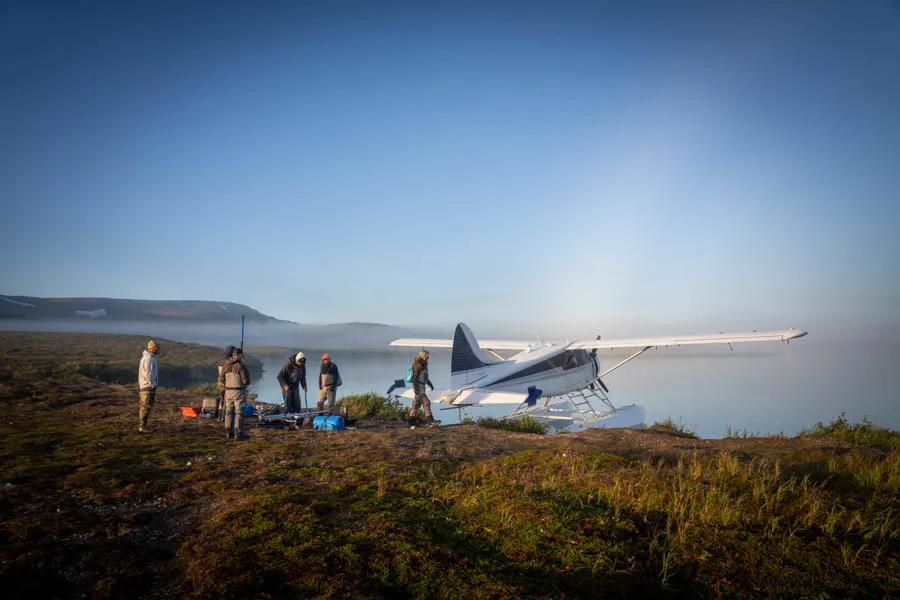
Alaska stands alone as a fly-fishing destination, a singular pinnacle in a world full of fish. The diversity of species from rainbow trout to Dolly Varden, Arctic char to grayling — not to mention salmon species — offer the angler myriad fly-fishing opportunities. Alaska’s enormity is dwarfed only by the vastness of the Pacific Ocean which fosters many of its fisheries. To fish here is to come face-to-face with a wilderness Alaska fly fishing trip with a bounty only a few anglers get the chance to experience.
I remember seeing a photograph nearly 30 years ago now. I was a college student at the time studying fisheries biology at Montana State University in Bozeman and fly fishing in Montana as much as I could. It could have been published in Field & Stream Magazine or one of my text books, it matters not. What I remember so vividly was that color red. Rivers coursing with it. Sockeye salmon so thick you could walk from one bank to another on their backs. It seemed unreal that such an image could exist. It was proof of what the world is capable of, an abundance so staggering it is beyond our comprehension. I swore that one day I’d wade in one of those streams, surrounded by sockeye salmon, to witness their final journey to the place of their birth. Soon I would be at one of the premier fly fishing lodges in Alaska.
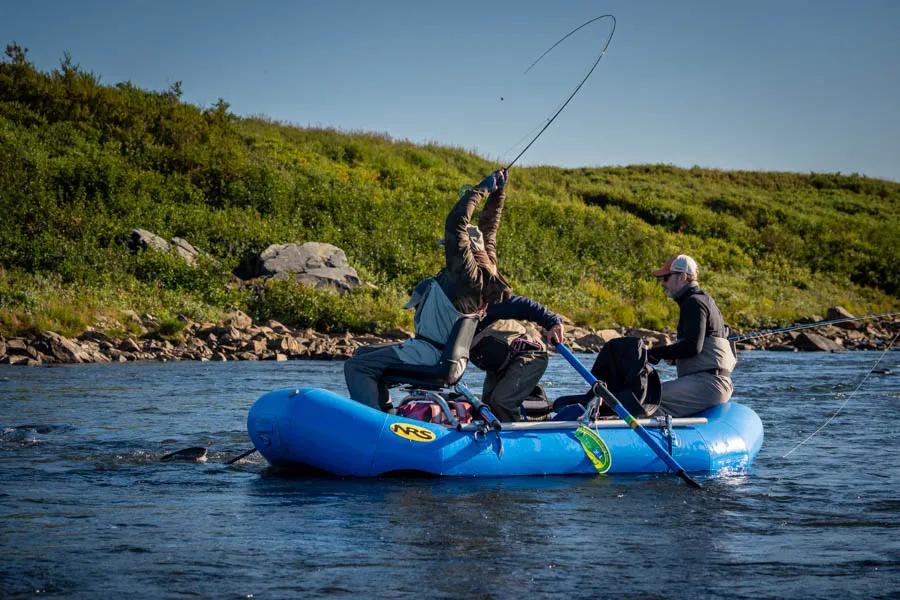
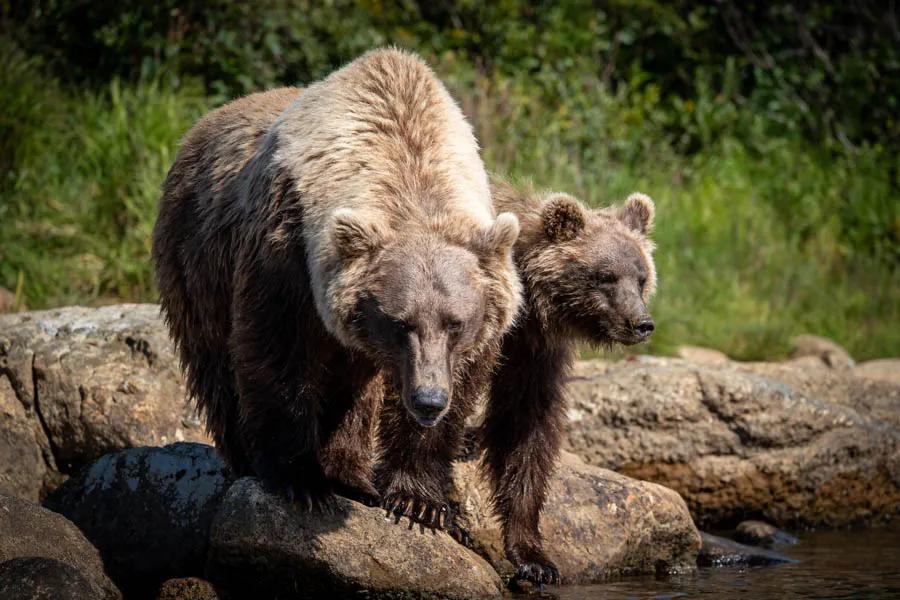
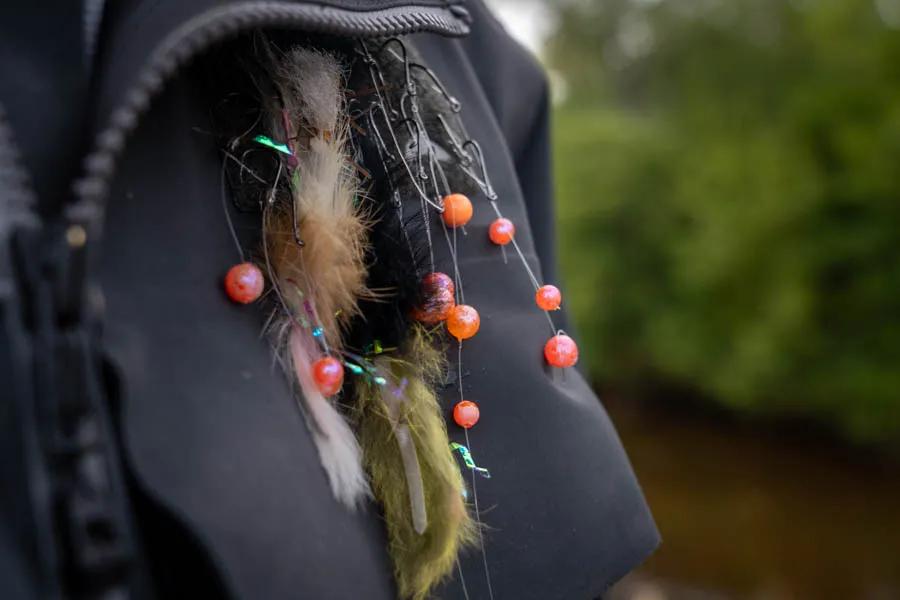
Fast forward to August 2025. I boarded an airplane in Bozeman. My destination: Alaska fly fishing's unique Intricate Bay Outpost on the southern shore of Lake Iliamna. I was to meet a group of anglers from Birmingham, Alabama, at the Lakefront Hotel in Anchorage. Together, we’d fish for big rainbow trout in the great waters that feed Lake Iliamna. And we’d do it during the height of the sockeye salmon run.
All Along to the Outpost
I met Charlie Watkins and the ’Bama Boys at the Lakefront Hotel on what could have been Anchorage’s biggest day of the summer. President Trump had announced a summit with Russian President Vladimir Putin the day of our arrival. Luckily, we all snuck into Ted Stevens Anchorage International Airport which is the main airport for most fly fishing trips in Alaska. The Lakefront felt as though we’d walked into a John le Carré novel. The hotel bar was full of Russian and American security personnel, many in plain clothes, who had apparently booked the same hotel as us. Signs set in the lobby were in Russian. The scent of clove cigarettes wafted in through the sliding front entryway of the hotel. Side glances and suspicion seemed to abound, but somehow the hotel maintained a pleasant air.
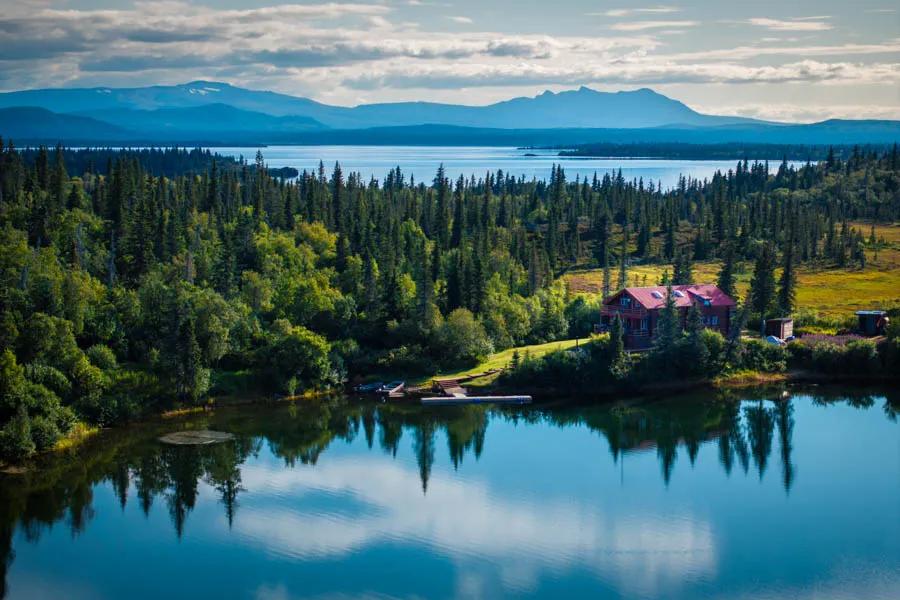
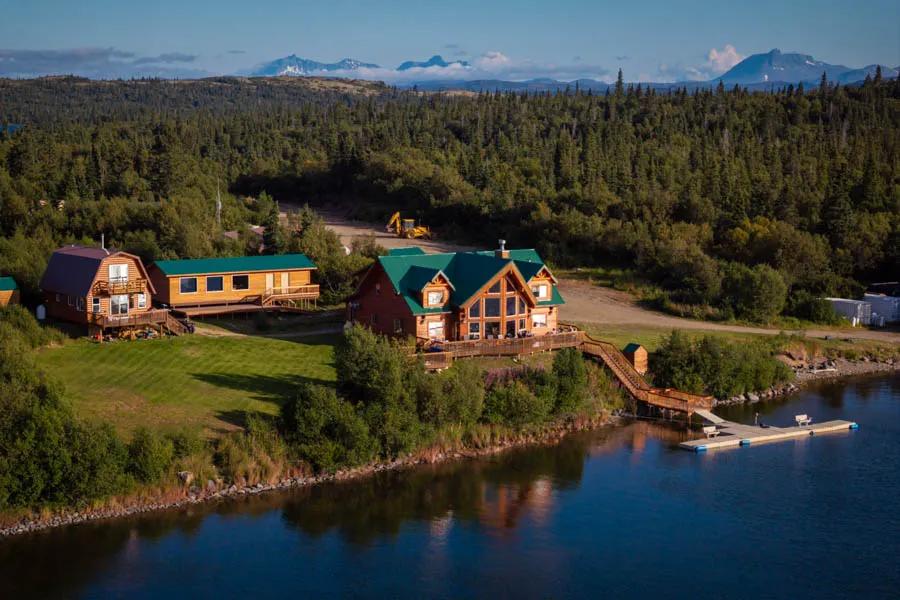
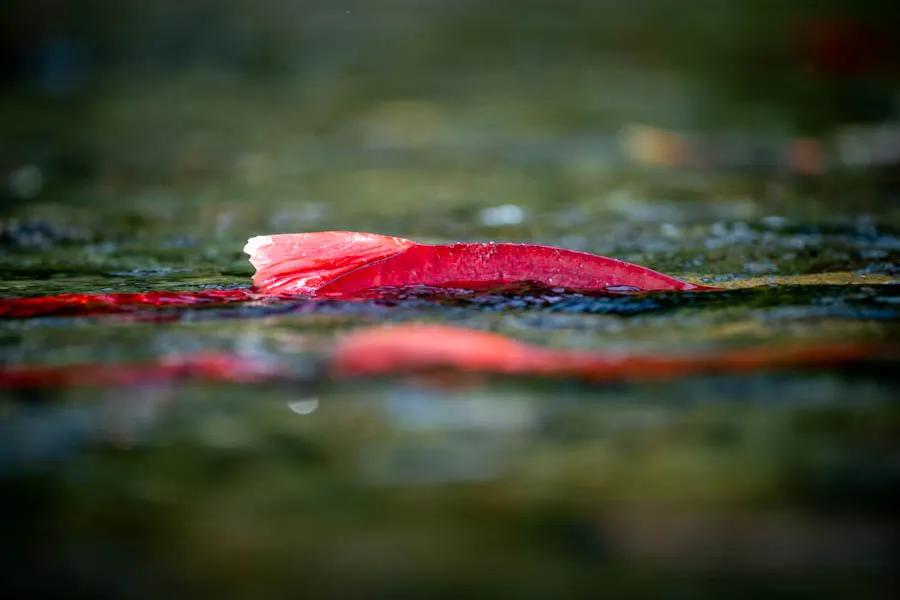
For pure entertainment value (and the closest proximity to beers), we dined in the hotel restaurant with the spies. Charlie was accompanied by Bo Kirkpatrick (Big Bo), Samuel Bowen (Little Bo), Greg Vedel, and Brent Hitson. The boys all grew up together in Birmingham. Greg had made his way to Montana for a client meeting some years back and had the chance to cast a fly rod on one of our Montana Angler fly fishing trips. There was something special about fly fishing he told his buddies when he got back south. That discussion spurred and an annual trip to Montana that has seen the group fishing together for more than 20 years, frequently with the crew from Montana Angler. To fill out the roster at Intricate Bay Outpost, the boys invited along Little Bo’s friend and co worker William Woodall (Bud), of Birmingham, and his son Dan Woodland, or Asheville, N.C. The volume of laughter emanating from our table drew a few nervous glances from the KGB types, and it took me all of five minutes drinking beers with the boys on the patio of The Lakefront to realize this was going to be a pretty fun trip.
After a restless night’s sleep, we woke early to catch a regional flight southwest of Anchorage across the Cook Inlet and the wilds of Lake Clark National Park to Lake Iliamna. It’s hard to appreciate the grandeur of the Alaskan wilderness until you’ve witnessed it from the air. As we crossed the Alaskan Mountain Range we peered down at glaciated volcanic peaks. Snowfields rippled like waves of water with pressure fissures. The volcanic geology descends from the alpine to verdant valleys stoked greener than you can imagine by the endless summer sun.
Touchdown in Iliamna. We were met at the airstrip by Brian Harry, owner and operator of Intricate Bay Outpost and Intricate Bay Lodge, two of Alaska's best fly fishing lodges. He greeted us in hip boots with a firm handshake. Brian’s the kind of guy that been working in Alaska long enough that its become a part of him. He spends the off season working out to be in shape for the rigors each summer season throws his way — and there have been a few. Expert bush pilot, lumberjack and dinner host are of a few of the many roles he plays, all with a smile and infectious energy that drives the momentum during a week of fishing.
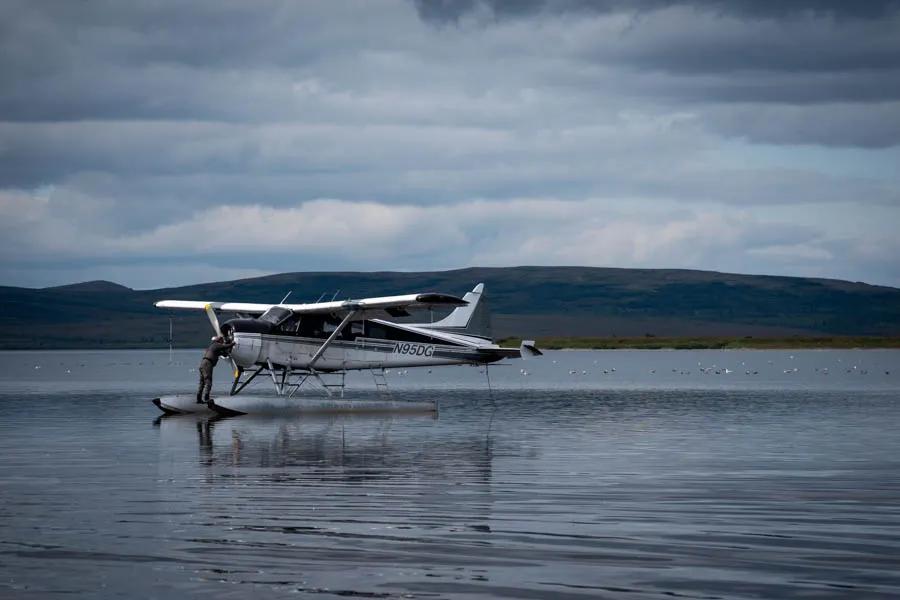
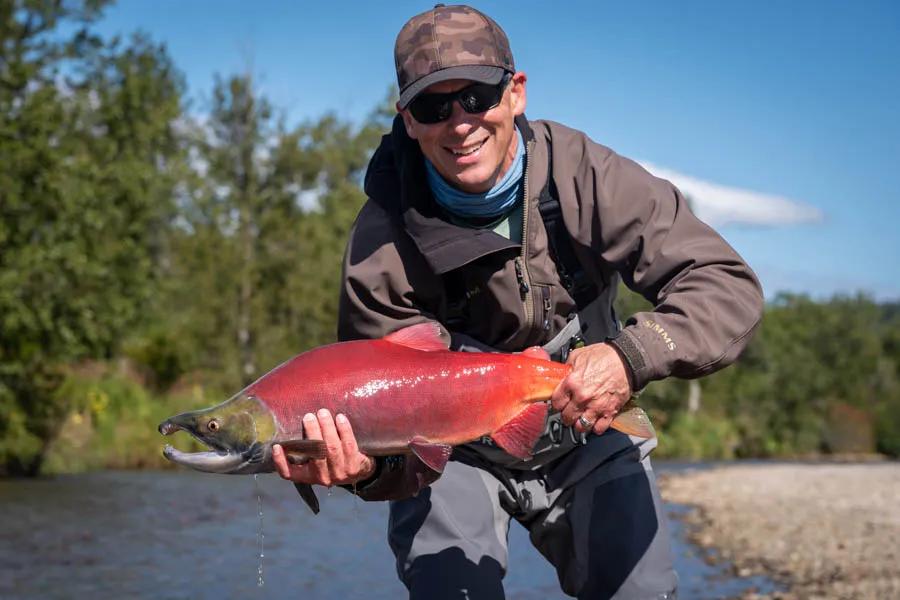
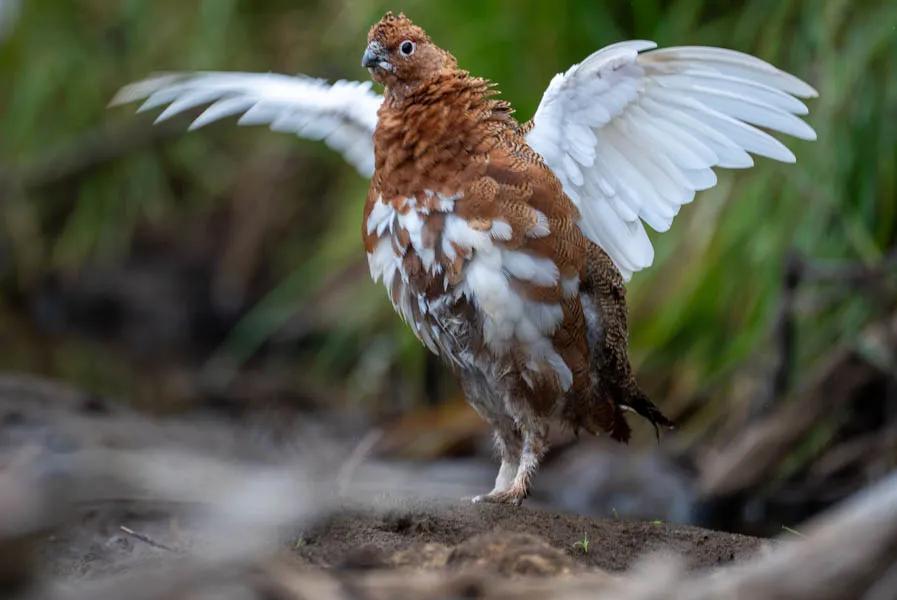
After a short truck ride and the first of daily float plane flights we were greeted at the Outpost by host Katie and chef Pat. Katie is small in statue, but big in positive vibes. Her demeanor somehow makes the Alaskan sun shine when fly fishing in Alaska even a bit brighter. Chef Pat worked the restaurant scene in the lower 48 until he decided for a change of scenery and brought his culinary skills north. He’s got a laid-back character that belies the exuberance and artistry of his cooking. Each night at the Outpost was filled with cuisine that impressed and satisfied without the need for embellishment — just good food, done right.
After settling our affairs, we donned waders for our first venture into Alaskan waters. I cannot tell you how nice it is to be fishing the day of arrival, and the boys excitement was palpable as we boarded Brian’s float plane and took flight for the Copper River.
Copper River
One of the great things about fishing out of Intricate Bay is the proximity to world-class fisheries. Lake Iliamna is fed by numerous waters, nearly all of which hold fish and see runs of salmon at differing points throughout the season. The Copper River when fly fishing in Alaska is one of Intricate Bay Outpost’s home waters and our first flight over it was jaw dropping. The volume of salmon we saw from the air on the short flight from the Outpost was amazing. Enormous schools of fish appeared in the eddies behind boulders, in the calm pools along the edges and in the belly of deep runs. More impressive perhaps was the volume of fish surging upstream in the shallows. The backs of big males pushing water could be seen from the airplane. Countless red dots lined the river from bank to bank. This is the stuff of Planet Earth and BCC nature documentaries, and to witness it firsthand was a dream come true for all of us.
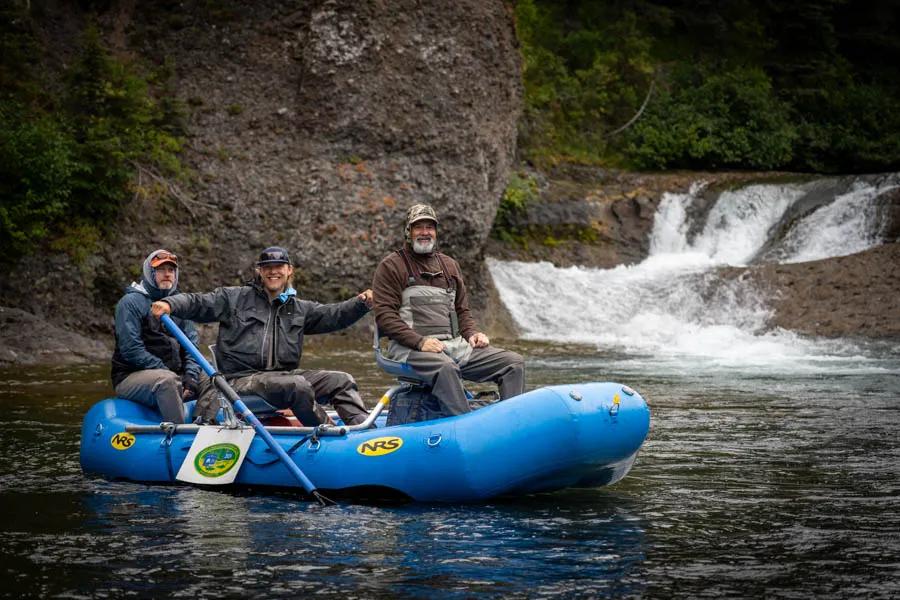
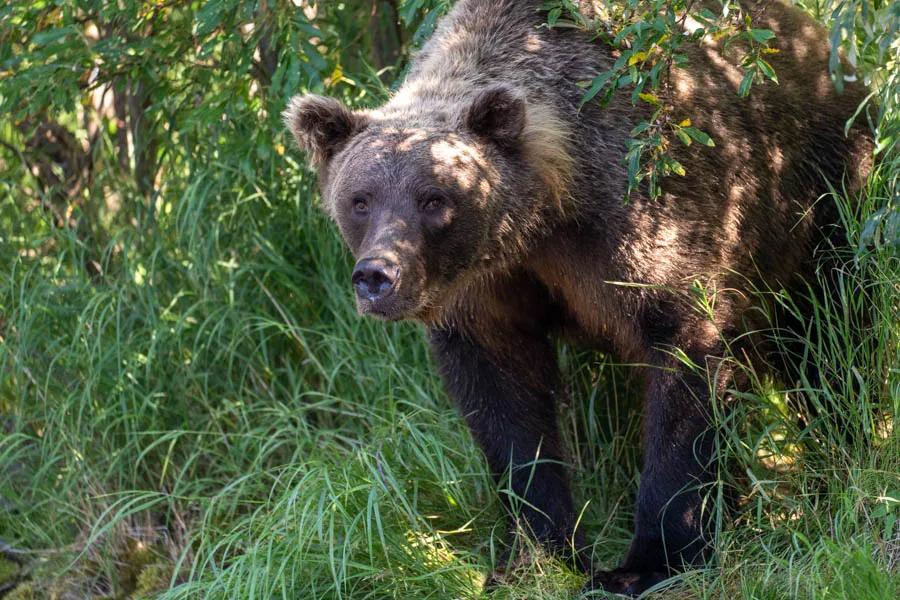
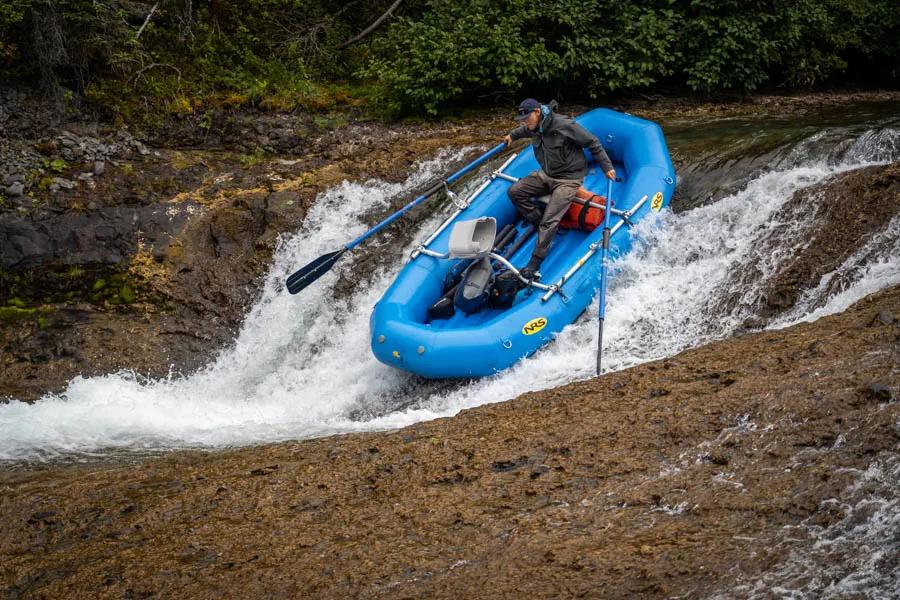
After unloading from the plane, our guides Kris and Evan assembled and inflated NRS rafts for a run down the Copper to Lake Iliamna. I’d fish this day and for the remainder of the trip with Charlie. Big Bo and Brent would join us each day in a separate boat with the remaining four of Little Bo, Greg, Bud and Dan venturing to other waters for the day. Charlie rigged a 6-weight and I rigged a 7-weight for our first day of fishing. Recommended rods for the waters surrounding Lake Iliamna are 6- to 8-weight rods, with 6-weights preferred for the rainbow trout and 8-weight rods the choice for salmon fishing.
Rainbow trout were our main target on this trip. While resident rainbows are present in the Copper throughout the season, it is the migratory fish from Lake Iliamna that provide much of the sport when fly fishing Lake Iliamna. These rainbows swim up the Copper River to feed on eggs dropped in the millions by female sockeye salmon during the spawning run. The river is quite literally turned into a massive spawning bed with fish making use of the entire river bottom to form their nests. Fly selection is as straight forward as it can get when fishing for rainbows during the August sockeye run: You’ll be fishing an unweighted egg pattern rigged just above a bare snelled hook on a 10-foot leader to an indicator. The eggs preferred by guides on the Copper
River are small plastic beads in 6mm to 8mm sizes. Colors vary from red to pink to orange. The guides have come up with creative names for each egg color. The Oregon Cheese, Montana Roe and Tangerine were hot patterns during our week.
Functionally casting a 10-foot leader to an unweighted egg pattern with a 6- to 8-weight fly rod takes a bit of getting used to, but most of the best fly fishing lodges in Alaska have guides who can help. The idea for presentation is to have the egg pattern float free in the current as if dropped by a salmon. Having a bit of bow in your line to maintain tension to the fly is acceptable. The key to success is to know what the take or a trout looks like versus the incidental hookup of a sockeye. Kris explained things well enough to Charlie and I on day one. A rainbow take will pull the indicator down and often to the side aggressively. As the sockeye are not feeding during their spawning run, they do not target the eggs. As a result, a sockeye will slowly drag the indicator under as if snagged, which they often are. In practice it is quite remarkable to cast into a sea of sockeye and have your egg pattern float free to find a rainbow trout somewhere feeding in their midst.
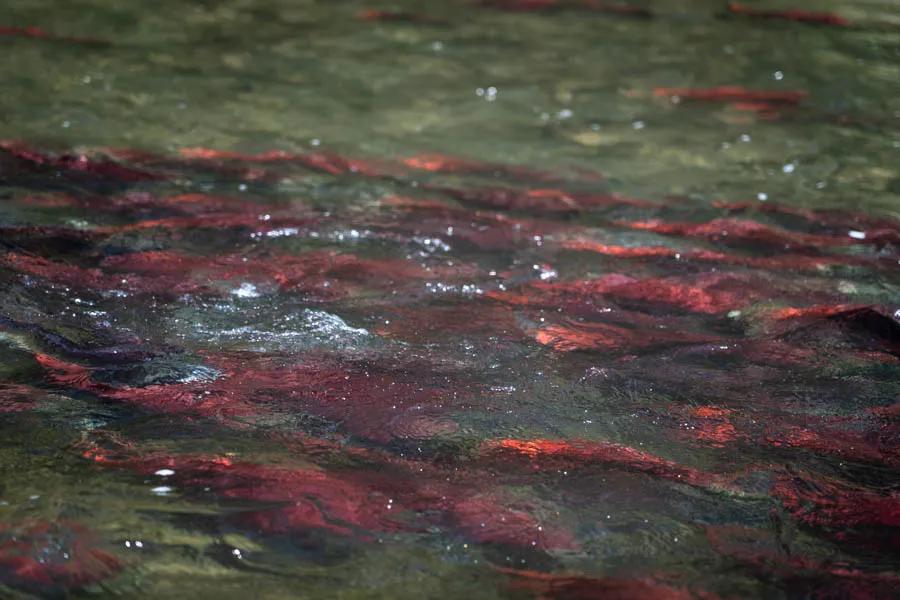
Charlie and I were both dumbstruck by the sight of the salmon. They’d surge from the water with each oar stroke, run themselves up on gravel bars, swim free in huge groups in the most mesmerizing fashion. The transmogrification of these fish is remarkable, something beautiful and horrific at the same time. In a matter of weeks the sockeye enter the river of their birth chrome from the sea. As they begin their spawning run their bodies shift in hue to a bright red, their head taking on a green tone. The males develop enormous humped backs that protrude out of the water like a blaring beacon to grizzly bears. Elongated jaws spew a tangle of sharp teeth. As the fish hold in the fresh water of their birth their skin begins to decay. Lesions appear. Their eyes start to rot from their heads. Fins disintegrate to spiny nubs. The notion of zombie fish is apt. Fortunately for us, we were at the front end of the run and most of the sockeye were in a state of solidity. Charlie hooked into a big male that proved too powerful for his 6-weight rod. Rather than fight an unwinnable fight, we were told by Kris to straight-line the salmon to the boat, where he’d hand line them in for release with a pair of pliers to avoid their protruding teeth. We each snapped a photo with a sockeye, but quickly found more engaging sport with the Copper’s rainbow trout.
Charlie’s first hook up put a bend in his rod unlike anything he’d felt during his 20-plus years fly fishing in Montana. Rainbows this big aren’t unheard of in when fly fishing in Montana, but they are certainly rare. And the charged up strength of these Lake Iliamna rainbows was something new entirely. For whatever reason, lake run fish just seem to fight harder than their fluvial brethren. Having built a solid skillset over the years fishing Montana trout streams, Charlie took little time to find his groove in Alaska. By the end of our first day he’d landed a handful of solid Alaskan rainbows. The rest of the boys from Alabama had done the same and the first evening back at the Outpost was filled with stories of the largest trout any of our anglers had ever caught.
Gibraltar River
The day begins early at the Alaska fly fishing lodge of the Intricate Bay Outpost. Each morning we rose for breakfast between 6:30-7:00am with float planes arriving to take us to the river around 7:30am. The Gibraltar River, which flows from Gibraltar Lake into Lake Iliamna, lies southwest of Intricate Bay Outpost. Brian picked Charlie and I up in his plane for the short morning flight across the tundra. Touching down on Gibraltar Lake was breathtaking. The surrounding tundra extends in all directions pocked by countless tarns and patches of white lichen that look from the air like snowfields surrounded by seas of green. Big Bo, Brent, Charlie and I rigged up our rods on the lakeshore as guides Evan and Justin prepared the rafts. We watched Brian throttle the engine and lift off as the sun peeked over the horizon and cast a shaft of dawn light across the Alaskan wild.
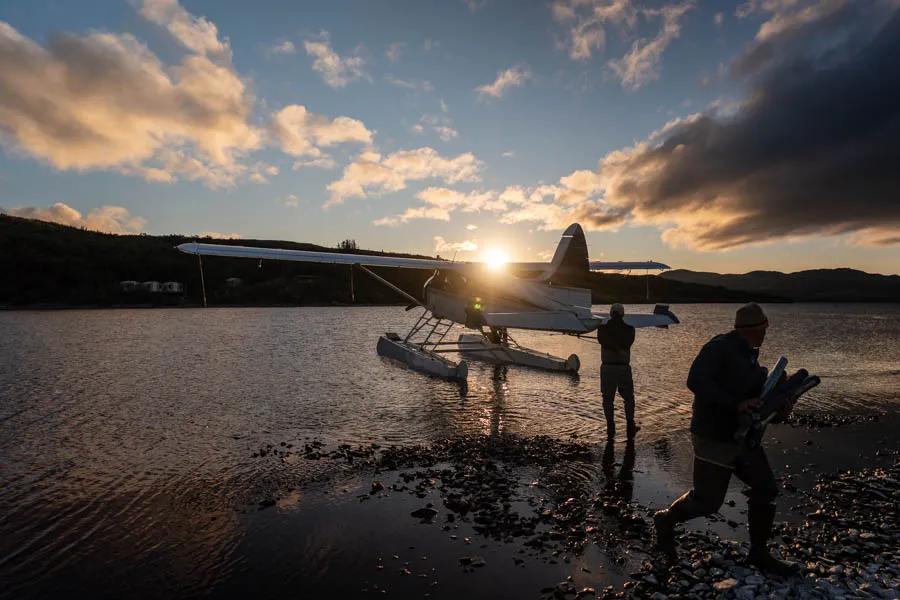
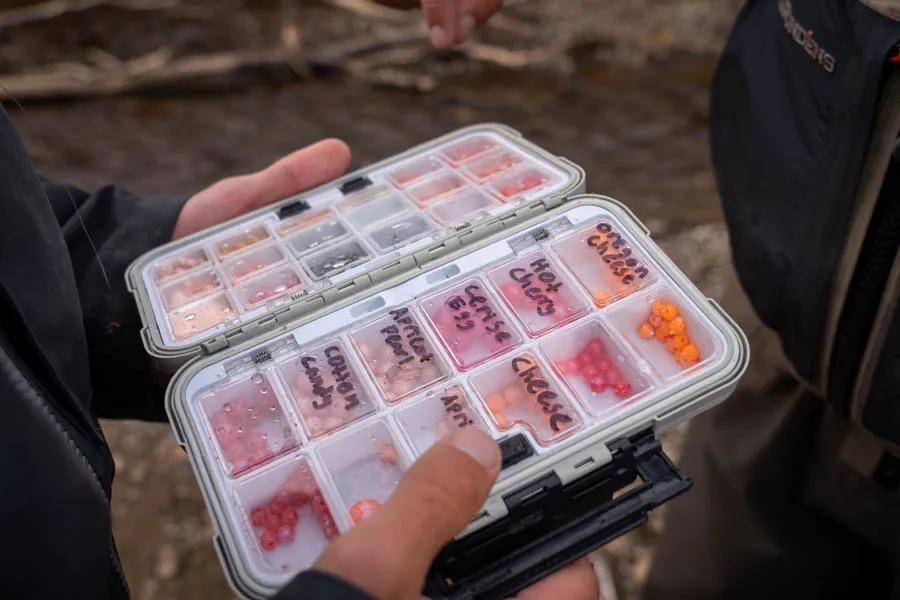
One thing that really surprised me about fishing the streams around Lake Iliamna is the size of the water. The Gibraltar River, like the Copper River, is a relatively small waterbody, approximately the same size or perhaps even a bit smaller than the Gallatin River here in Montana. As such, the pools are apparent and the wading opportunities plentiful. On the Gibraltar, Justin would lead Charlie and I downstream to a likely looking run and we’d hop out to fish. Charlie really roped them on the Gibraltar and I could see by Day 2 that he was a competent angler with a good level of skill. Even with the unwieldy egg rigs, Charlie managed accurate casts and was able to manage his line well. The strikes began to come in bunches. By
the end of the day Charlie must have landed more than a dozen rainbows, each of which would have been a personal best any other day.
The Gibraltar River flows stunningly clear in August, which is in the ideal season to go fly fishing in Alaska. Its banks are lined with mixed forest of deciduous and evergreen trees. And everywhere you look there are signs of grizzly bears. Bear paths line both sides of the river, almost like tunnels in the brush. You can see spots where bears have bedded down and spots where salmon have been half consumed and left to rot. So it came as little surprise when we rounded a bend and witnessed our first grizzly bear of the trip. The big sow was crossing the river in front of us and she quickly disappeared into the forest on the far side of the river. I’d barely had a moment to raise my camera for a photograph and she was gone. But as I glanced back downstream another bear appeared on the near side of the river. It was up on the bank and look straight at us with a serene gaze, completely at ease in our presence. We floated by less than 20 feet from this magnificent looking bear, happy as could be with a belly full of sockeye.
As we worked our way downstream Charlie continued to put on a clinic. At one point we stopped with Big Bo and Brent, all three hooking into healthy rainbows and having the best day of fishing any of us could imagine. For the remainder of the trip, every time we’d round the corner and see Big Bo it would seem he’d be hooked into a fish.
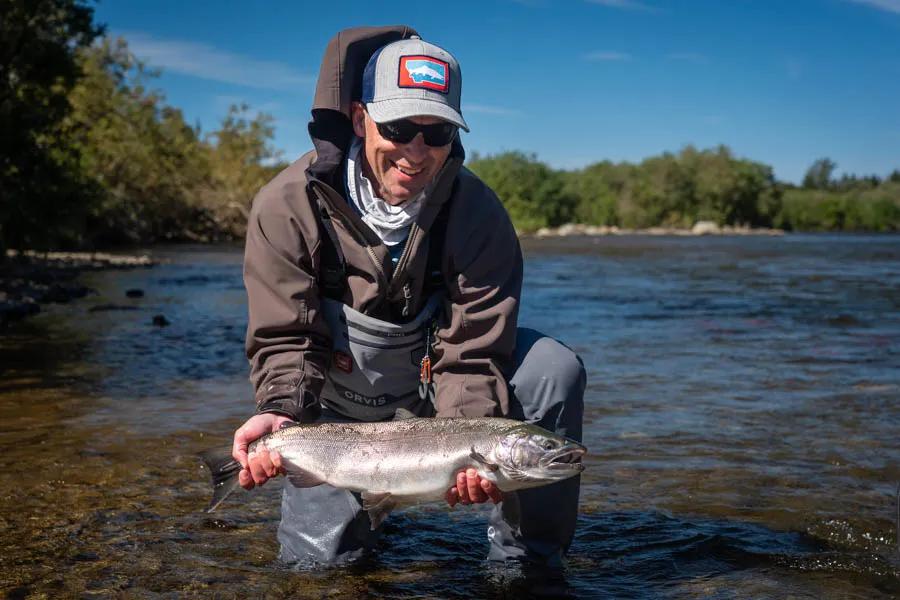
Toward the end of the day Justin pulled the boat over in a particularly picturesque run. There was a line of riffles and runs that provided plenty of spots to wade fish for rainbows. Charlie hooked into and released a few good fish. Just as we were ready to get back in the boat and head downstream we noticed a dark fish among the sockeye. “That’s a silver!” Justin exclaimed. Silver salmon move into the Gibraltar following the sockeye run, so this was an early fish. Charlie got a good look at the silver and moved himself into position to make a cast. The silver took! Charlie managed to sight and catch the only silver salmon we saw on the entire trip. The fish put up a solid fight and came to the net. We captured a few photographs and a bit of video footage before releasing it back to the Gibraltar. I could see the thrill Charlie got catching that fish. There is nothing quite like sight fishing!
The Little Ku
Day 3 saw Charlie, Big Bo, Brent, and I fly off to the tundra from our great Alaska fly fishing lodge, Intricate Bay Outpost. We were to fish the day on foot on a small stream called Nanuktuk Creek, aka The Little Ku. The Little Ku is a tributary of Kukaklek Lake, which holds a different strain of rainbow trout than Lake Iliamna. Brian landed the float plane on a small lake about a mile distant from the creek. We had lunch packed for the day would fish the creek down to the lakeshore. Watching Brian disappear in the plane over the horizon really left us with a feel of being the only anglers on the river.
The Alaska tundra is like a giant sponge. When the rains come, the tundra soaks up and holds moisture. Composed of mosses, lichens and various tundra plants, it's an incredibly unique and fascinating environment to experience. It’s also very difficult to move through. Each step in the tundra feels like five. You sink down into the lushness of the tundra like beach sand on steroids. It can be exhausting. Our first few steps onto the tundra felt as though we were walking on a water bed. Each footfall sent a ripple across the ground such that we could feel each other moving. Fortunately, the ground firmed up after a couple hundred yards and we were able to follow a bear trail. Along the way we stopped to eat a few blueberries that had ripened to perfection under the long Alaskan sun.
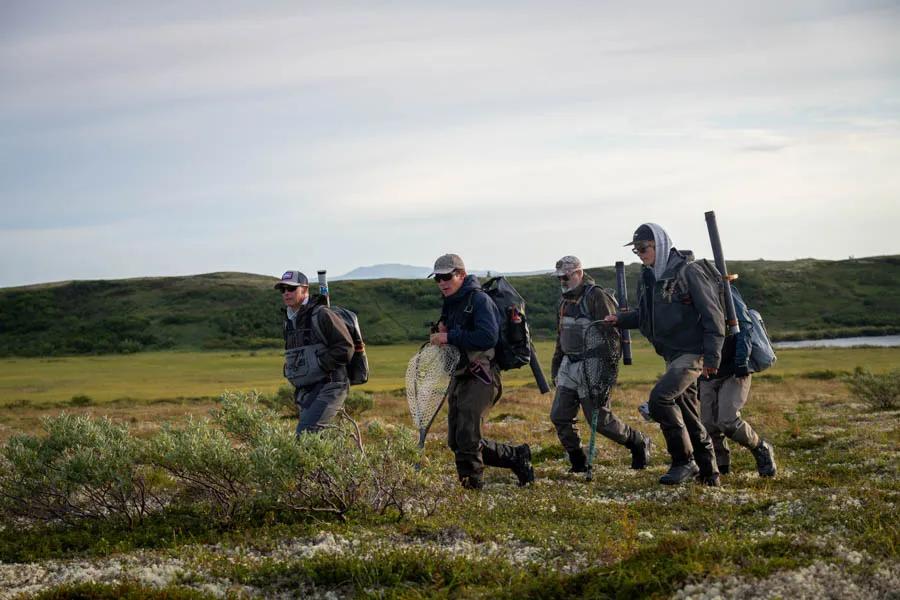
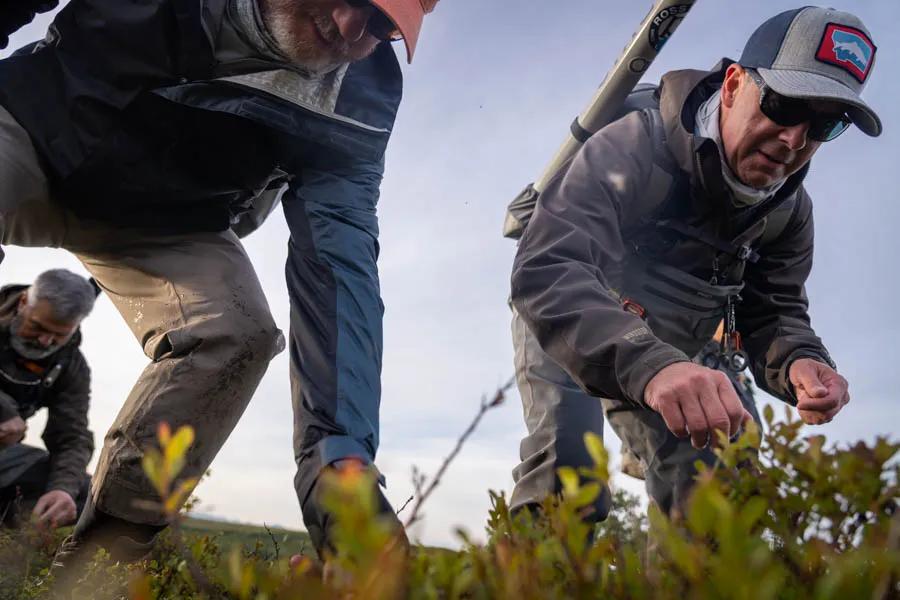
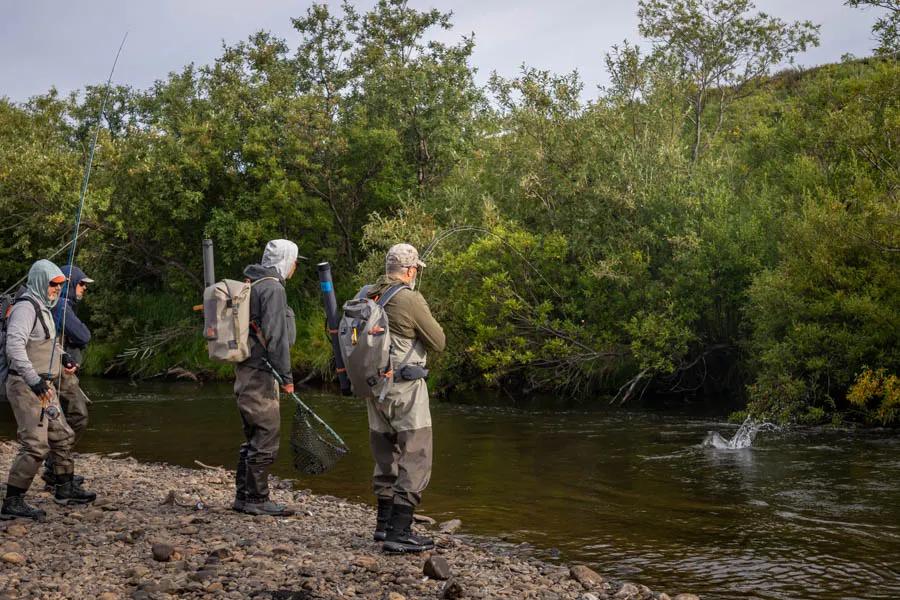
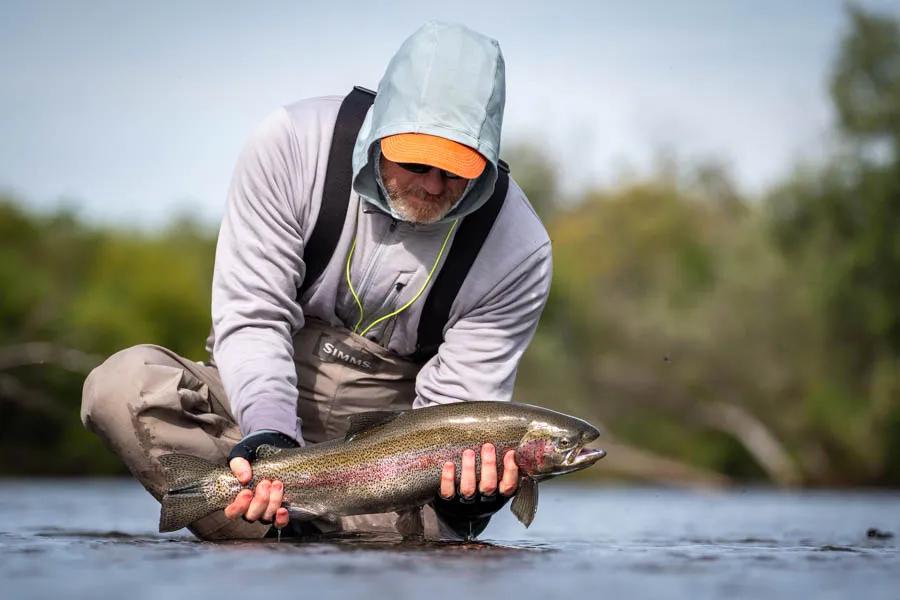
The Little Ku was a lot further along in the sockeye run than either the Copper or the Gibraltar. As such, there were many more dead salmon along the bank. The scent of dead sockeye, at least to my nose, smells less like rotting fish and more like the ocean. The guides said it can become pretty overpowering in the late weeks of the run, so if you’re adverse to the smell, try to book your trip in early to mid August. Being a tundra stream, there were a lot of mosquitos on The Little Ku, but their numbers seemed to drop to a manageable level when we were on the water. The Little Ku was the only river where mosquitos were a concern during the trip. A good bug spray or a head net would be advisable for anglers fishing The Little Ku or other tundra streams in Alaska.
Fishing together with Big Bo and Brent was good fun. Both anglers shared Charlie’s experience on Montana fly fishing waters and that skillset served them well on The Little Ku. While there are plenty of first-timers that catch heaps of fish in Alaska, building some fly-fishing skills before your trip will certainly add to your enjoyment of the experience.
The Little Ku is set in a small valley framed by distant mountains that cuts through the tundra before reaching Kukaklek Lake. Imagine it as a small stream covered in dense brush surrounded on either side by a bench. This is the kind of stream you might fish somewhere off the beaten path in Montana. The kind of place with enough willows and forage and cover to draw in moose and grizzly bears. The kind of place you’d want to be alert, but where the Alaska fly fishing is so good it's worth the risk.
Not long after we started downstream we encountered a massive sow grizzly in the middle of the river feeding on salmon. She was a good 50 feet from us when we saw her and she seemed completely unbothered by our presence. It’s quite a different feeling to be in the presence of such an animal on foot rather than in a boat, but whatever tension we may have initially felt faded quickly as she slowly moved downstream and disappeared into the brush. We waded alongside keeping an eye in the brush and following her in parallel as she navigated a side channel downstream. We appeared below her and watched her fish for salmon for a few moments before continuing to fish. With the grizzly less than 100 feet from us, Big Bo hooked and landed what was at that time the fish of the trip, a stunning 25-inch rainbow trout that fought like the monster it was. Brent was next to hook up, landing a strong Kukaklek-strain rainbow of his own.
The day ended with a scenic flight back over the tundra to Intricate Bay Outpost. We were greeted with what would become a standard evening treat: cookies fresh from the oven by chef Pat, and another wonderful dinner hosted by Katie.
Back to the Copper
Intricate Bay Outpost fishes several reaches on the Copper River and you can explore the full length of the river during your stay. Perhaps the most scenic stretch of the river is in its upper reach, which begins above a twin-tiered waterfall. The waterfall acts as a fish barrier, so the first part of the float is strictly scenic. Charlie, Bo, Brent and I couldn’t have asked for more dramatic scenery. Guides Kris and Trace rowed us through a narrow canyon with towering walls of volcanic stone. The water here is luminously clear and it really instills the feeling that you’re deep in the Alaskan wildness.
After a short float, Charlie, Bo, Brent and I disembarked above the first of the two major falls on the upper river. These first falls flows over a chute that plunges into a deep pool. Kris and Trace secured the boats before dropping the falls, a clear thrill for our guides. After another stretch of rapids the roar of the lower falls echoed up the canyon. We pulled the rafts to the shore and gathered the gear to portage. These falls were much more significant than the first. The plan was to drop the boats unmanned over the falls and retrieve them below. Overlooking the brink of the falls, we could see hundreds of sockeye salmon staged in the pool. The fish would leap from the river and vanish into the falls, trying in vain to reach the river above.
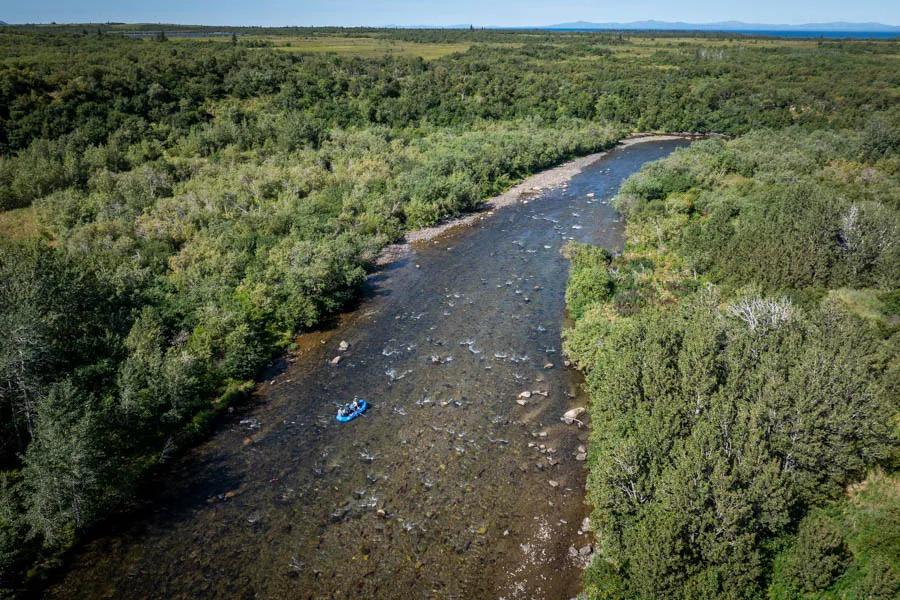
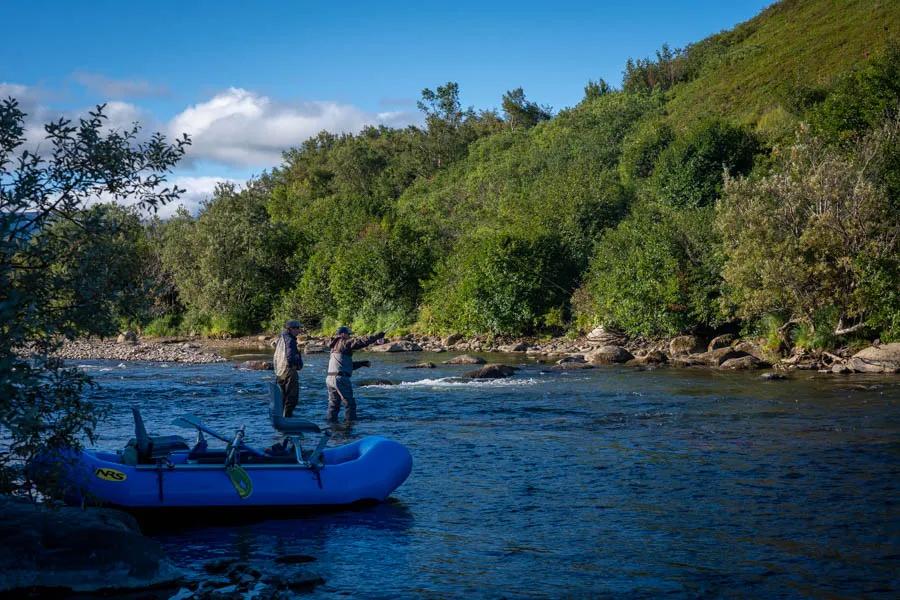
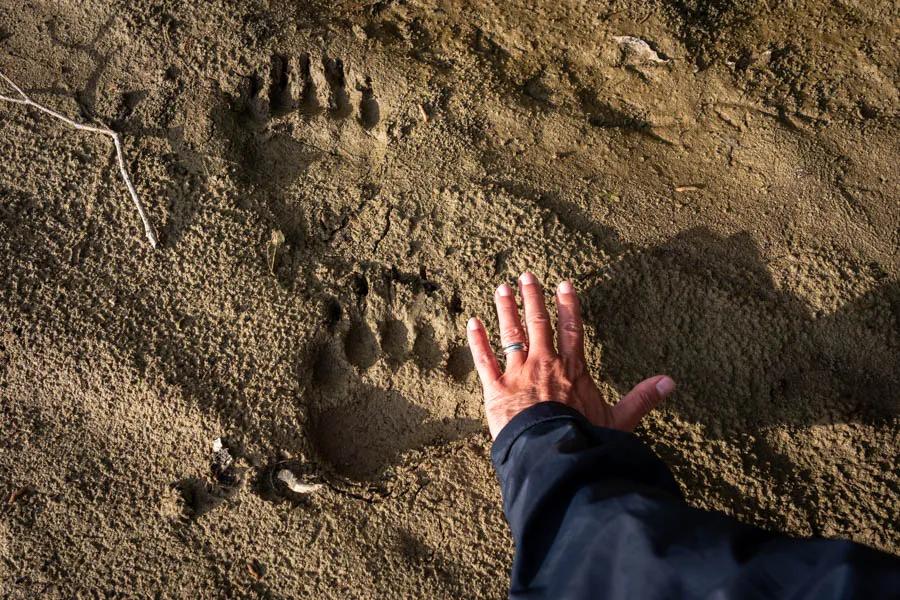
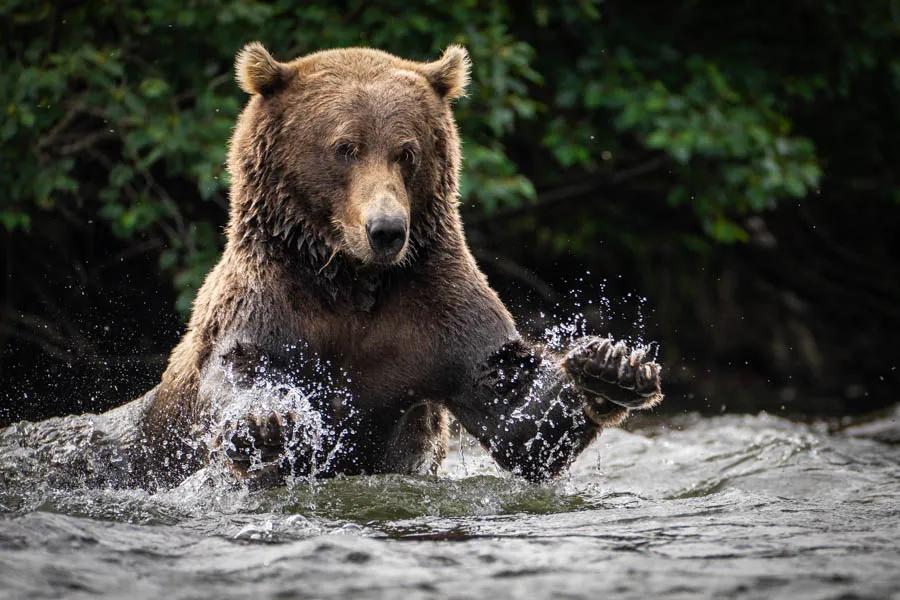
Once we’d reached the bottom, Trace and Kris hiked back above the falls to release the boats. We watched them glide smoothly to the precipice and tumble over the brink. Charlie, Brent and Bo waded out into the pool to collect the rafts as Trace and Kris navigated the hillside to join us. We watched the salmon leap into the surging midst at the base of the waterfall as we rigged our rods for what would be one of our best days of fishing.
Charlie got things going in short order. The water below the falls was as clear as any we’d seen on the trip and we spotted several nice rainbows swimming in the midst of the sockeye. Charlie hooked up with a pair of nice fish, the first of which came free and the second which he landed in the river just below the falls pool. These were big, strong Iliamna rainbows and each fish put a solid bend in Charlie’s rod--the kind of action we were used to when fly fishing at the Intricate Bay Outpost.
With excellent water clarity, we began to look for rainbows within the masses of sockeye. Occasionally we’d spot the blue-gray back of a rainbow trout as we’d drift through the red tide of salmon. It became a little game akin to Where’s Waldo of picking the one rainbow out of the bunch. As Charlie and I fished together for the remainder of the week, we’d hone our sight- fishing skills, working together to target specific fish. We stopped for lunch with Big Bo and Brent at a particularly productive run that held more than half a dozen actively feeding fish. Charlie and I spent an hour working the rainbows, eventually hooking a few. Sight fishing would be our method of choice for the rest of the trip.
Moraine Creek
Katmai National Park is a short flight from Intricate Bay Outpost. The park is remote with no vehicle access. The only way to reach Katmai is by airplane or boat. The park is home to the largest protected population of grizzly bears in the world. An estimated 2,200 brown bears call the park home. A chance to fish in the presence of Alaska’s grizzlies is a unique experience and one I was looking forward to.
We boarded the plane with guides Evan and Justin for the flight into Katmai. We’d be fishing Moraine Creek, which despite its name would be the largest water we’d fish on the trip. Our chance to reach the creek was a bit dicey with morning fog creating visibility challenges for Brian. The fog created an ethereal scene as the dawn light cast a golden glow over the tundra. Brian circled the plane around the landing area. A couple other float planes were already on the water, so he needed to line up a safe spot to land. After a pass we came in for a smooth landing. “Never a dull day in Alaska,” he told us as he pulled back the throttle and eased us into shore.
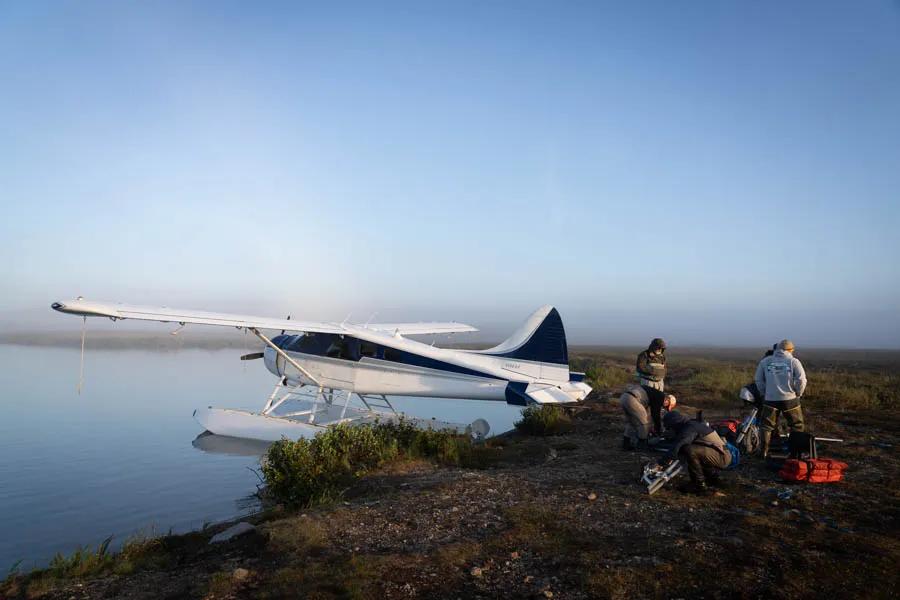
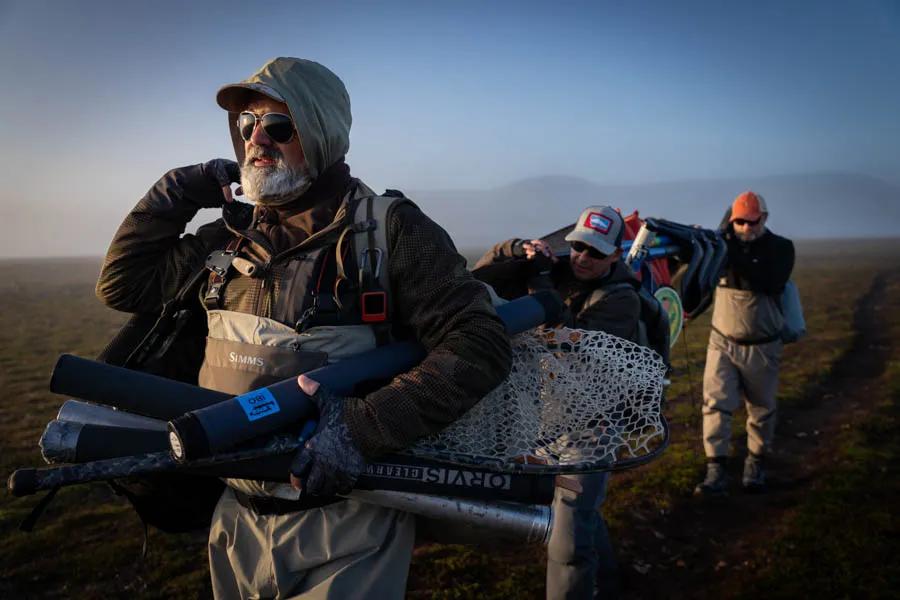
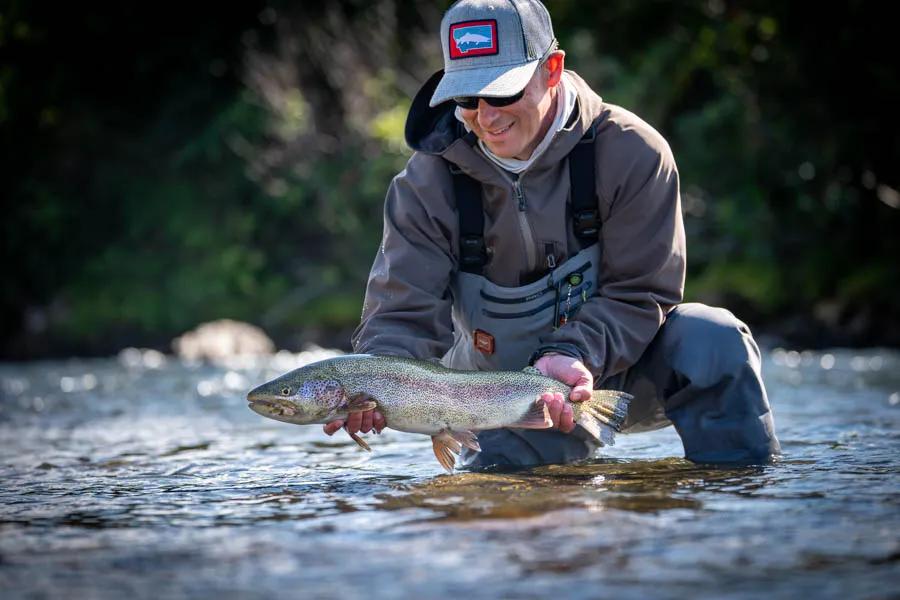
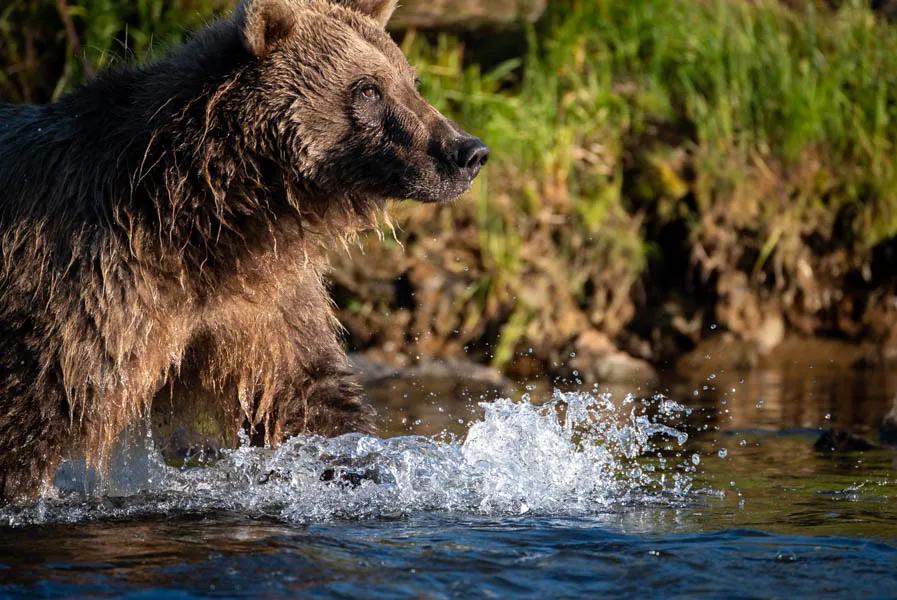
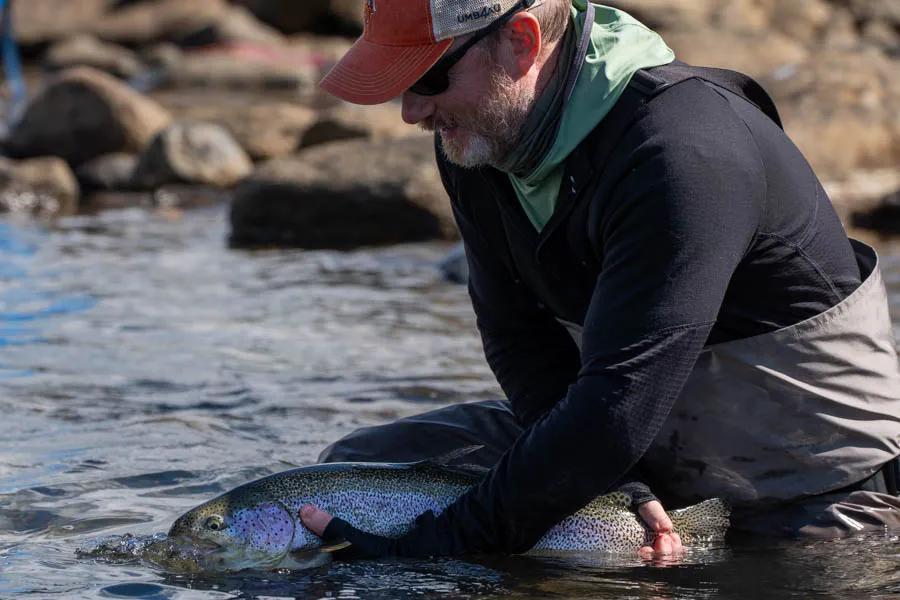
Reaching Moraine Creek from the landing area requires a short walk across the tundra. With boats, oars and fishing gear in tow, Big Bo, Brent, Charlie and I set off for the creek. The fog made for a memorable walk and the boys excitement for the day was apparent. Moraine Creek was meant to have not just big bears, but big fish as well. After inflating the boats and rigging the rods, we began our float. The first bear of the day appeared in minutes, fishing in the shallows of a side channel. We saw several others in the first half hour, which set the tone for the day.
Moraine Creek is a diverse piece of water. It has broad flat sections, riffled runs, boulder gardens and deep pools. In short, it’s got something for everyone. Who knows if that’s why the bears like the fishing here so much, but I’d wager it’s a solid bet. We didn’t keep count, but over the course of the float we must have seen more than 40 grizzly bears. Each bear had its own unique method of fishing. Some bears would snorkel just beneath the surface of the water looking for fish. Others would sit on the creek bank eyeing fish from above. We saw a big boar watching for the backs of salmon in the shallows before chasing them down and tackling them. In all, it was an exceptionally entertaining way to spend the day.
The rainbows in Moraine Creek seemed to exceed the size of the fish in the other rivers we’d explored. Big Bo landed the biggest trout of his life, and the biggest fish of the trip, in a riffle a short distance from a sow and cubs. Bo put everything into the fight and Evan did a great job with the net to land the fish. The rainbow taped an amazing 27 inches!
Charlie picked up two stunning rainbows on the Moraine. Colored up in deep pinks and greens, these fish must have been resident to the creek, rather than the chrome lake runners migrating up from Iliamna. Dinner back at the Outpost was filled with plenty of laughs as we all recalled an amazing day of fly fishing in Alaska.
Over The Rainbow
Alaska had been good to us. The ’Bama Boys had all caught their personal best trout many times over. The hospitality and dinners at Intricate Bay Outpost had exceeded all expectations. The bear viewing was out of this world and the scenic float plane flights with pilots Brian and Roy had opened our eyes to expansive beauty of Alaska. When Charlie and I set out for our last day of fishing on the Copper River, it was hard to imagine anything could top what we’d already seen.
That all changed with the final fish of the trip. We were floating the lower section of the Copper, which flows in Lake Iliamna. We’d had a great day with a number of good rainbows brought to the net. Justin had been great at the oars all day, putting us on fish. Together we’d sighted a number of good rainbows and managed to catch a few.
As the day grew long we pulled the raft onto a gravel bar. Charlie and Justin worked a run near the boat and I headed downstream. A small side channel of the main river dipped below some brush and plunged into a pool. Beneath an overhanging branch I eyed a rainbow moving side to side in the shallows. I signaled to Charlie to come over and pointed out the fish. “You going to cast to him?” Charlie asked. “No,” I said. “I want to see you catch him.”
The fish was in a tough spot. It would require a good cast to land the egg deep enough beneath the branch to present to the fish. The drift wouldn’t allow time for the indicator to come into play. “Just keep an eye on the fish,” I told Charlie. Charlie’s first drift was a bit shy, but he managed a deeper cast on his second attempt. The fish shifted out and we watched its mouth open to take the egg. Justin and I shouted “Set!” in unison as Charlie raised the rod tip. The line came tight and rainbow rushed out from beneath its hide. Charlie fought the fish toward the gravel bar and Justin got the net beneath it. It wasn’t the biggest rainbow of the trip, but it was a great team effort and a wonderful moment to watch the entire scene play out — the perfect fish to end a perfect trip to one of the best Alaska fly fishing lodges.
